Monstera dissecta are stunning tropical plants that are often grown as houseplants. They feature large, attractive foliage which, when paired with their easy-to-care-for nature, make them the perfect plant for any indoor garden.
These climbing plants are not fussy, which makes them ideal for beginners – though experienced gardeners will also enjoy growing this rare plant.
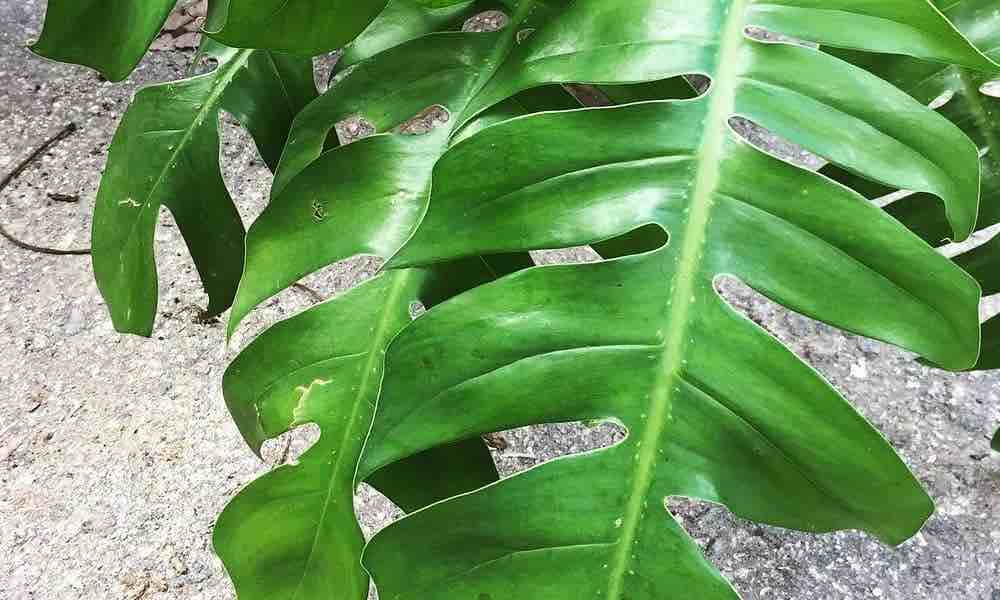
Table of Contents
Monstera dissecta care
Monstera dissecta is a rather easy plant to care for. With that said, however, you will need to provide this tropical houseplant with its ideal growing requirements to ensure the Monstera dissecta thrives for years to come.
1. Monstera dissecta needs well-draining growing medium
Like other Monstera varieties, the dissecta requires rich, organic soil that is light, airy, and well-drained. For best results, the pH balance should fall somewhere between 5.5 and 7.5. You can purchase potting soil or make your own by combining 3 parts orchid bark with 1 part sphagnum moss, 1 part perlite, and 1 part horticultural charcoal.
The most important thing to remember when it comes to picking the best soil for your Monstera is to choose one that isn’t compact, as this makes it harder for the water to move through the soil. If you’re unsure as to which soil to use, select one that is designed for indoor tropical plants.
2. Provide the Monstera dissecta with high levels of humidity
Monstera dissecta is native to the tropics, which means it thrives in areas with high humidity. In fact, this plant grows best when it has a humidity level of at least 65%, though the higher the humidity the better.
Increasing the humidity level in your home can be done by either using a humidifier or sitting the plant on a pebble tray. Whenever you water the plant, the excess water flows out of the pot and onto the pebble tray. The water will then evaporate into the air, naturally increasing the level of humidity.
Related: 12 Proven Tips to Get Your Monstera the Humidity It Needs
3. Indoor temperature is important for this tropical houseplant
Monstera dissecta is a tropical plant that grows in USDA Plant Hardiness zones 9 to 11. This Monstera grows best at temperatures between 60 and 80 degrees Fahrenheit, and cannot tolerate low temperatures and frost. While this Monstera variety can handle temperatures as low as 50, it isn’t recommended to expose this plant to such low temps for an extended period of time.
Another thing to consider is that the plant should be kept away from areas where the temperature can drastically fluctuate. This could be near a front door or next to a heating and cooling vent.
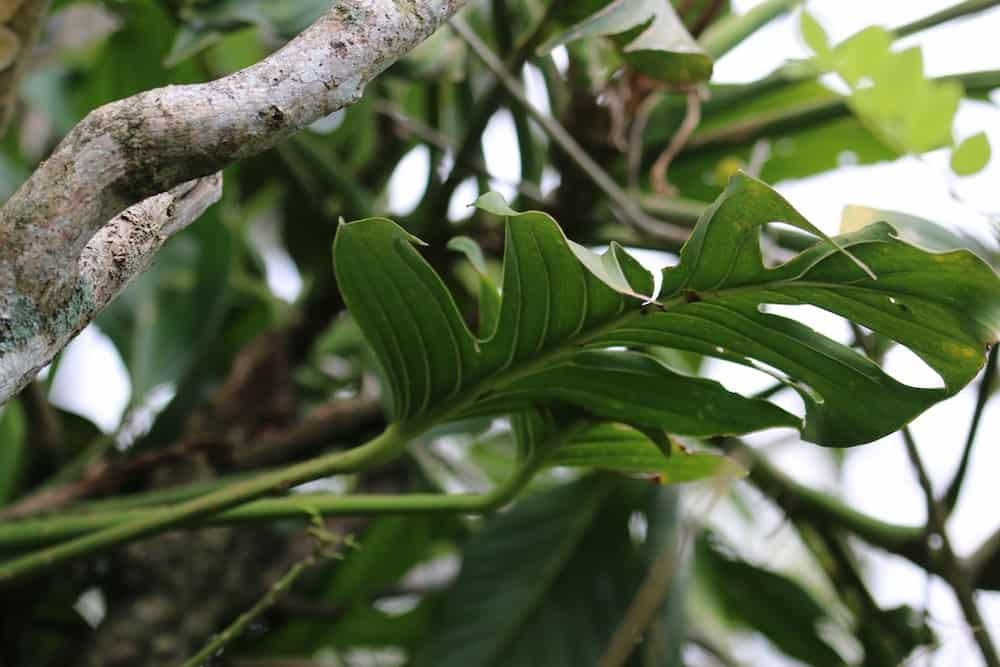
4. Keep the Monstera dissecta well watered, but avoid overwatering
One of the quickest ways to kill your Monstera dissecta is incorrect watering. Whether it be too much water or not enough water, not giving the plant the right amount of hydration will result in a wide array of problems.
Too little water will cause the Monstera to wilt, become dry, and have stunted growth. Too much water leads to leaf dropping, soggy stems, and fungal diseases.
How to do this: Monstera dissecta enjoys moist but not soggy soil, and allowing the soil to dry out a little between waterings will help prevent problems.
Instead of having a set schedule for how often to water your Monstera, check the moisture’s soil level by inserting the tip of your finger into the top one to two inches of soil. Water the plant deeply if the soil feels dry, or wait another day before checking the soil again if it still feels moist.
5. Monstera dissecta grows best in bright yet indirect sunlight
Given that Monstera dissecta needs bright indirect sunlight for ideal growth, you should avoid putting the plant in direct sun. This can cause the plant to burn and, if exposed to direct sunlight for an extended period of time, result in stunted growth.
With that said, however, the Monstera dissecta shouldn’t be placed in low light or artificial light. Instead, select an east-facing window for the plant to grow in. You can diffuse the sunlight with the help of a sheer curtain.
6. Give the Monstera Dissecta a boost with fertilizer
As with just about any other plant, the Monstera dissecta can benefit from fertilizer applied during the plant’s growing period. Select a fertilizer designed for either Monstera or tropical houseplant, and apply once a month during the spring and summer months.
Stop applying the fertilizer to your Monstera when the plant is in its dormant period, which is during the fall and winter months. You can also add green waste from your home to fertilize the plant. Green waste includes fruit peels, egg shells, and coffee grounds.
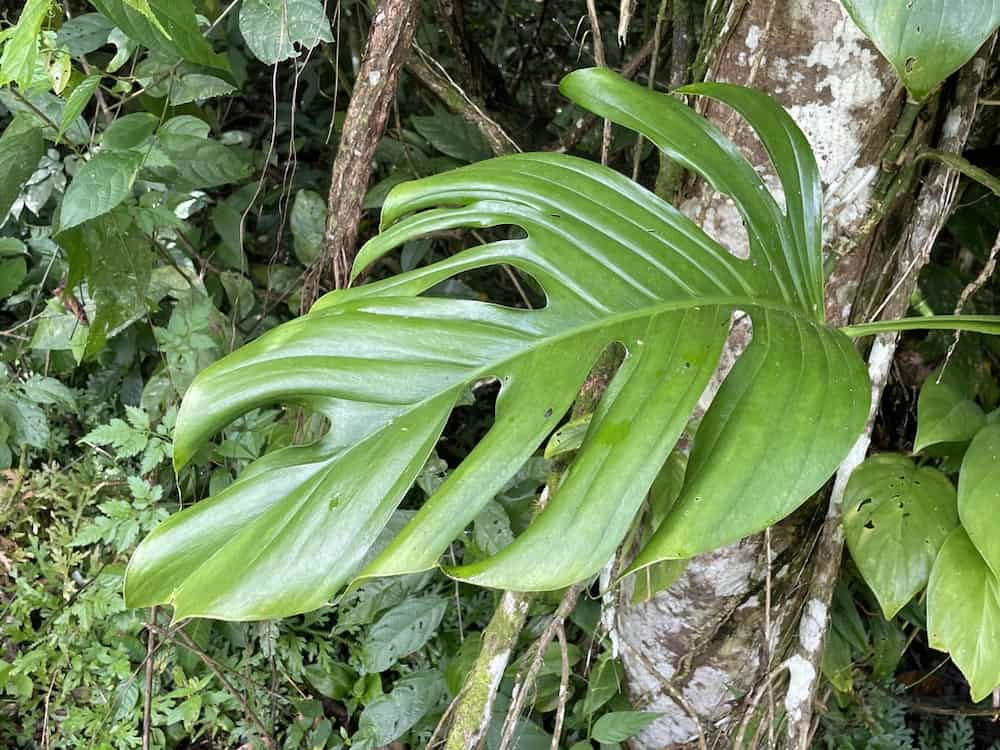
7. Repot the Monstera dissecta every few years
The Monstera dissecta will need to be repotted every few years when the plant starts to become root or pot bound. If you see roots growing out of the pot’s drainage holes, the plant is pot bound and needs to be repotted.
When repotting the Monstera, make sure to select a container that is 2 to 3 inches larger than its old pot. Furthermore, the container will need to have drainage holes at the bottom, not along the sides, of the container. This will allow for the excess water to drain out of the pot without having to build up to a certain level.
8. You can propagate the Monstera dissecta to increase the amount of plants you have
Propagating isn’t a requirement of the Monstera dissecta, but it does give you the ability to make more plants from your original Monstera. These plants can be kept for yourself, or given to friends and family.
In order to propagate this Monstera variety, you simply need to take a 4 to 6 inch cutting from the plant’s stem. This cutting will need to have at least one leaf node, as well as a few healthy leaves on it. After it has been removed from the plant, insert the cutting, leaf node side down, into a pot filled with well-drained potting soil.
9. Regular pruning isn’t required, but can help maintain the Monstera dissecta
As with most other Monstera varieties, the dissecta doesn’t need to be pruned regularly. However, you can prune your Monstera plant to remove damaged or dead foliage. If you do prune the plant, use clean and sharp pruning shears, and always discard the removed plant matter.
You should also never prune more than 1/4 of the Monstera’s leaves as this can cause the plant to go into shock, resulting in stunted growth. In fact, the Monstera dissecta doesn’t do well with aggressive pruning, and you should prune sparingly.

10. Be wary of pests that can attack the Monstera dissecta
Just as with other houseplants, the Monstera dissecta can experience pest problems. The most common Monstera pests tend to be soft-bodied ones, such as spider mites, thrips, mealybugs, scales, and aphids. While these pests are annoying, they are typically easy to control.
When you notice the pests, act quickly by applying insecticidal soap or neem oil. Both of those pesticides are non-toxic and won’t harm people or pets, which makes them ideal for indoor use. Make sure to always follow the application directions on the bottle.
Related: 4 Quick Steps to Get Rid of Scale on Monstera
11. Watch for root rot and other diseases
As with other Monstera varieties, the Monstera dissecta is susceptible to root rot. This fungal disease is difficult to treat once it has set in and can quickly kill the plant. Thankfully, root rot is easy to prevent and keep at bay.
The best way to prevent root rot in your Monstera is to avoid overwatering the dissecta, and making sure it is growing in well drained soil. Soggy soil will cause the plant’s roots to become water-logged, which then results in root rot. Another way to prevent this fungal problem is to only plant the Monstera dissecta in a pot that has drainage holes at the bottom and not on the side of the container.
12. Understand this plant’s toxicity
If you’re considering bringing this plant into your home, you should be aware of its toxicity level. The Monstera dissecta is toxic to cats, dogs, other pets and people. All parts of the plant are toxic, and when the plant is consumed, it can cause irritation to the mouth, lips, throat, and stomach.
The good news, however, is that the Monstera dissecta isn’t harmful if you touch it and is only harmful when consumed. So if your child or pet simply rubs up against the plant, it won’t harm them. That doesn’t mean you should allow children and pets to play with the Monstera.
Find out more: Is Monstera Toxic to Dogs? (+ 8 Tips to Keep Them Apart)
13. Practice good hygiene for the plant
While it may seem weird to read the words hygiene and plant in the same sentence, it is an important aspect of plant care that is often overlooked. Good hygiene is just ensuring that leaf litter and plant debris isn’t allowed to lie around the plant. These items are an open invitation to insects and diseases.
When you notice leaf litter and plant debris has fallen from the Monstera, pick it up from the floor or pot immediately and dispose of it. This small step goes a long way to keeping problems at bay.
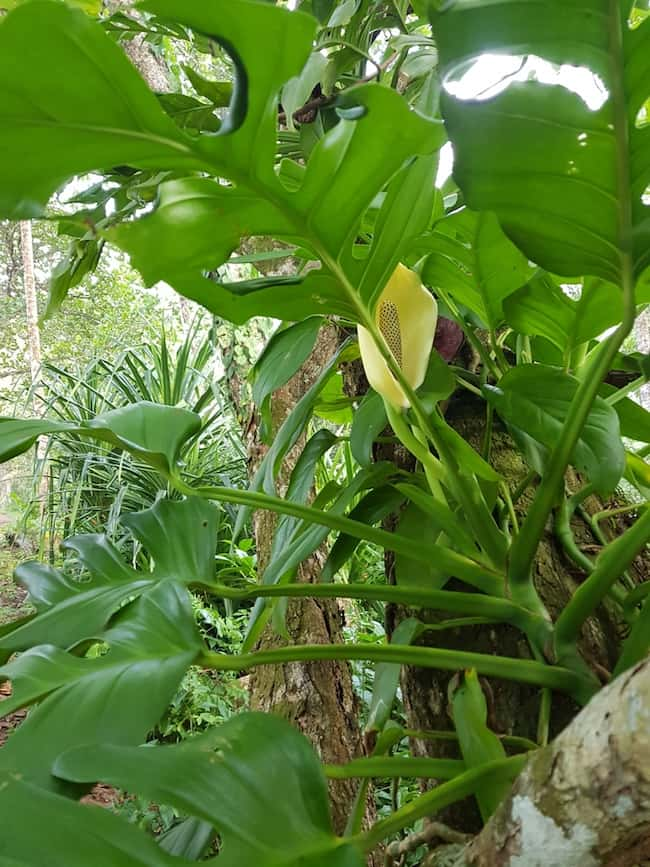
14. Keep the Monstera healthy
It’s common sense that you want your Monstera plant to be as healthy as possible. But did you know that a healthy Monstera is less likely to experience problems caused by insect infestations and diseases? This is because pests seek out unhealthy plants, since they are less likely to “fight them off” and are more desirable to consume.
An example of this is water-stressed plants. Water-stressed plants produce a concentrated amount of nitrogen and sugars, which means the insect can consume more food in a shorter period. Water-stressed plants also cannot produce as many chemicals as healthy plants to deter insects from feasting on them.
How to identify a Monstera dissecta
When the Monstera dissecta is still young, the leathery leaves have a glossy green color with an oval shape. As the plant ages, the foliage starts to split and become larger. One of the most telling signs of a Monstera dissecta is that at the top of the stem, the leaves will grow in a tight cluster.
Don’t be discouraged, however, if you’re unable to tell the difference between one Monstera variety to the next. The Monstera is a genus of over 40 species, most of which look very close to one another. Because they look so similar to one another, it can be rather difficult to accurately identify them.
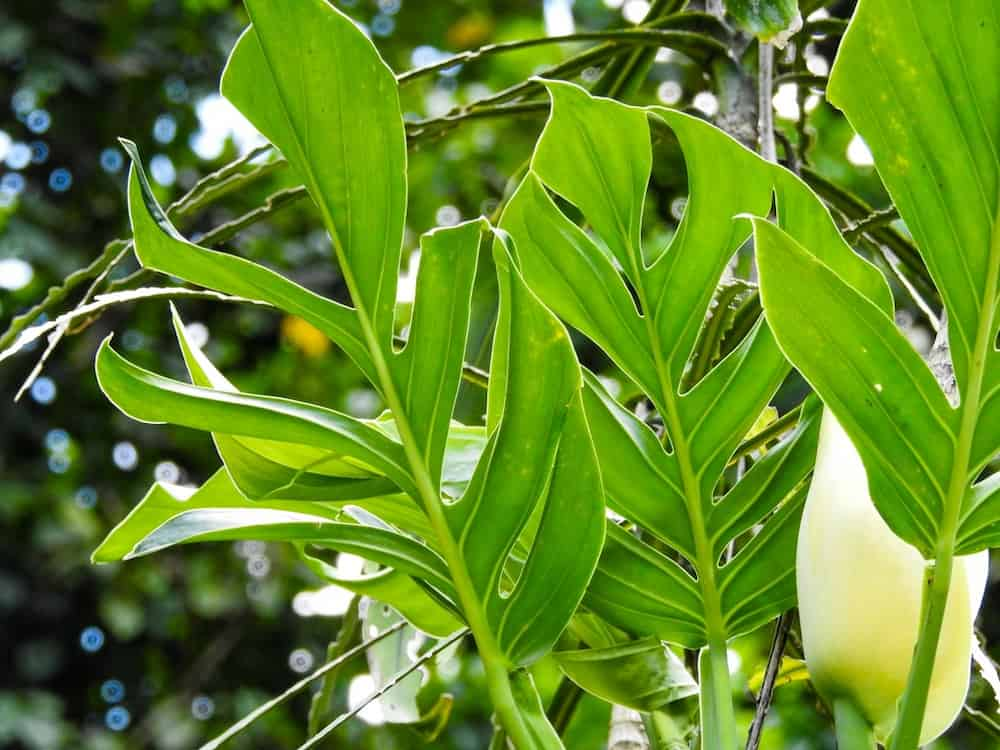
Monstera dissecta vs Monstera spruceana
The main difference between Monstera dissecta is that the dissecta features a tight cluster of leaves that form at the top of the stem. The spruceana, however, doesn’t have this cluster. While the two plants are very similar, looking for this tight cluster is the giveaway.
That is, if you notice a tight cluster at the top of the Monstera’s stem, you are more than likely looking at a dissecta. If it’s not there, you likely have a Monstera spruceana on your hands.
Monstera dissecta vs Monstera subpinnata
Both the Monstera dissecta and the Monstera subpinnata have pinnatifid leaves, which can make it difficult to tell the difference between the two. However, the subpinnata variety features pinnae that are narrower at the plant’s base, and they grow at a wider angle than the dissecta variety.
“Pinnatifid” leaves are when leaves have a featherlike arrangement, like in the diagram below. Most Monstera fall under the “simple” leaf arrangement below, often with large holes or “fenestrations”, but the Monstera dissecta and Monstera subpinnata have bigger, more uniform splits that look very similar to one another.

Is Monstera dissecta rare?
Monstera dissecta is not as readily available as other Monstera varieties, often because it simply isn’t grown by plant suppliers, which makes this type harder to come by. Because of this, the dissecta variety is considered rare, which will have a direct effect on the plant’s price.
The reason why this plant isn’t grown as readily as other varieties isn’t well known. After all, the dissecta variety is just as easy to care for as the more commonly grown Monstera deliciosa. No matter what the reasons, however, the ability to obtain this plant directly affects its price.
If cost is a concern, there are other more budget-friendly Monstera varieties that you may want to consider. They are just as fun to grow as the dissecta and will provide both interest and texture to any indoor garden.
What is a standard Monstera dissecta price?
The standard Monstera dissecta price varies greatly depending on the size of the plant. It is not uncommon for a large Monstera dissecta to cost several hundred dollars. Even a plant that is only a few feet tall can cost over $300.
A quick search on Etsy shows small cuttings of the dissecta are currently going for over $100. The high price tag for a small plant often turns people away. After all, who can really afford a few hundred dollars for a houseplant?
If you don’t want to shell out that amount of money for a plant but still want to grow a Monstera, consider the more common variety, Monstera deliciosa. A Monstera deliciosa that is several feet tall and well established costs under $100 and you can even find cuttings for only a few dollars.
Where do I buy Monstera dissecta?
You can find Monstera dissecta for sale at various garden centers and nurseries both online and off. Finding someone selling cuttings or joining a plant swap group can also be a good way to buy a Monstera dissecta, given they aren’t always readily available in stores.
That is, if your local stores do not offer this plant and they cannot order it for you, you can try to obtain a cutting from a friend or family member.
Another option is to join a plant swapping group online and ask if any members have a cutting of the dissecta that they would be willing to send you. Keep in mind, however, that you may have to give a cutting or plant in exchange for the dissecta cutting, or even pay for the cutting.
It is also possible to purchase the plant online, though this isn’t usually ideal, since shipping cost can increase the overall price of the plant by more than your budget allows. Because of this, purchasing the Monstera dissecta online should be considered a last resort.
